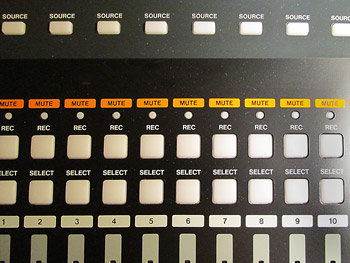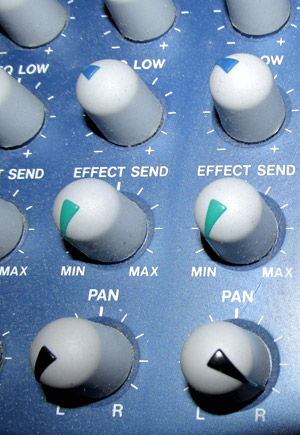RECORDING the Hammond Organ
North Suburban HAMMOND ORGAN Service
Here are few close-up pictures of digital multi-track recorders and their controls. From here we can activate a track to record, we can play back a track that is already recorded, or if we are working on a recording and want to listen only to certain specific tracks while making the recording, we can mute other tracks.

Figure 8. Some of the input controls on a digital multi-track recorder.

Figure 9. Panning controls on a digital multi-track recorder. We can see by the position of the two that show prominently in the picture that the tracks they control are set to play exclusively on the left and right channels.
For example, A singer who is recording an additional track in which she sings harmony to her first recorded track might only want to listen to her first track even though she may previously have recorded a piano or organ instrumental accompaniment.
One of the most important groups of controls on a multi-track recorder [or a mixer] comprises its panning controls. A panning control locates the individual track which it controls in the so-called stereo field.
For instance, if the control is turned all the way to the left, that particular track will only play on the left channel of the completed stereo mixdown. Likewise, if turned all the way to the right, it will only play on the right channel. If left in the center position, the track will play at equal volume through both channels. If you turn it to any intermediate position, the resulting track will play proportionally through both stereo channels, but will be more prominent on the channel which the control favors. For example, if we turn the control 25% away from the extreme left position, it still primarily favors the left channel, because it is 75% away from the right channel. Therefore, the track which it controls will predominate on the left channel, but it will also play at reduced volume on the right channel.
Another control group that shows in figure nine is the effect send group. If we wish to add digital reverb, or some other effect from a DSP, this control will allow a portion or all of the signal to be sent to a separate digital signal processor. So, for example, if we have a DSP set up to produce reverberation, then by adjusting the position of the effect send control, we can determine how prominent the reverb will be as compared with the direct signal on that particular track. This is very useful, because to achieve a really good sounding recording, we may have to use differing amounts of reverb on different tracks, depending on what is on a specific track.
Generally, bass and drum (rhythm) tracks should have a lot less reverb than certain instrumental tracks, because too much reverb on bass will make the bass notes sustain into each other. You’ve all heard this with some folks who play electronic organs that have pedal sustain. No matter what they play, they use the maximum amount of pedal sustain that the instrument provides, and, although they may feel that it covers up sloppy pedalwork, it results in a continuous bass line. Try this while playing something fast, such as a polka, and you’ll quickly hear just how bad it sounds. However, on many electronic organs you can only play one pedal at a time, so at least in that case, the long sustained bass notes won't overlap each other. Still, too much pedal sustain doesn't really sound all that great. Drum tracks likewise sound pretty terrible with too much reverb, especially a reverb that favors lower frequencies.
However, bass that immediately cuts out as soon as you let go of a pedal does not sound natural either. This is the [in my opinion] biggest defect in traditional Hammond organs. In this case, if we set a DSP to provide a reverb that favors lower frequencies, but also one that is extremely short (way under one second), we can secure a good pedal effect. Bass tones should have a very short roll-off or decay, and not end instantly. But there is a very fine line between a natural sounding slight roll-off on pedal notes and a sustain or decay that is too long.
Also important before we go too far is to define the two terms track and channel. Although there are exceptions, generally a track is a mono recording using one track on a tape or one virtual track on a digital multi-track machine. Channel refers generally to the right or left channel of the final standard stereo mixdown.
Back to Page 4. Page 5. Go to Page 6.